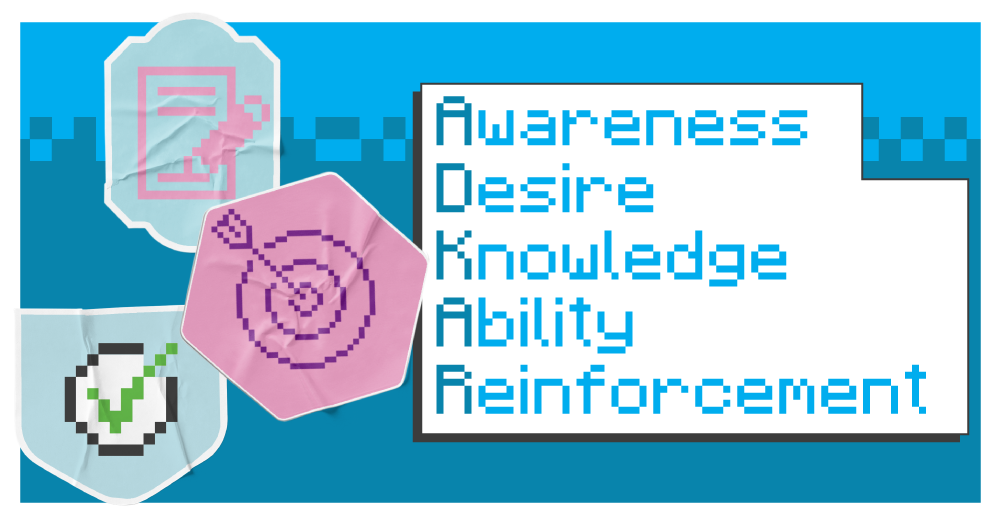Implementing new business technology requires significant investment of time, budget and resource. It often seems like an uphill struggle, from convincing leaders to sign it off to navigating the tricky technical road to successful deployment.
Given the effort needed, you naturally want your implementation project to make a difference. For most businesses, this means effectively alleviating pain points, improving performance and progressing objectives.
However, many projects suffer when it comes to long-lasting adoption. The hard work goes into deploying the new technology, only for the business to stay stuck in its old ways.
To prevent this happening to your project, you need to plan adoption and change management in advance. We’ve listed our top tips for ensuring long-term success that you can implement before, during and after implementation.
Why is long-term change management and adoption crucial?
First of all, let’s dive into why adoption and change management is so crucial for the long-term success of your technology. Asides from being frustrating when your efforts go to waste, it can impact business performance and costs.
Implementing new technologies always requires investment. Depending on what you’re introducing, this can be a significant sum. You want every penny of that to count.
By ensuring that your tools are used properly, you’ll experience a better return on investment. This means the value you’re getting a business – whether that’s reduced costs, added revenue or growth opportunities – is greater than what you’ve spent. The faster you can achieve ROI, the more cost-effective the project becomes and the more benefits the business receives.
This also speeds up timelines to realising project goals and eliminating challenges. That translates as less time being frustrated by inefficient systems or processes. Instead, you’ll be able to progress business objectives and mark them as complete, ready to take the next step in your growth and optimisation journey.
Finally, if you’re leading the project, lasting adoption is crucial to getting you the credit you deserve. If the project doesn’t fill its targets, why would you be trusted to do it again? But if it’s a success, you’ll be seen by the business as trustworthy and capable. This makes it easier to get sign-off for future projects and decisions.
In short: everyone benefits from the success.
7 tips for lasting adoption and change management_
1. Actively think about change management_
It may sound like an obvious one, but all too often project leaders fail to think about change management until they’re approaching launch. However, change management activities should be integrated into your project plan from day one.
Allocate time, budget and resources specifically for communication, training and addressing resistance. This makes it a core part of the project, not an afterthought. By investing consistently in these activities throughout the process, you’re less likely to encounter barriers after go-live.
A useful tip for doing this is to define clear success metrics for the people side of the project. How will you measure adoption, usage and satisfaction with the changes? Define these early, as it gives you something to work towards during the project delivery.
These metrics should be as concrete as your technical project metrics. For example, “80% of users actively using the new system within 3 months” is better than “users are satisfied.”
By pinpointing these targets early, you can plot the activity that will get you there and intervene when something is falling short, before it derails the success of your implementation.
2. Secure broad stakeholder engagement_
You likely know all too well the experience of getting the business to sign-off a change project. However, your efforts to influence shouldn’t just target your boss or the person who signs off the budget. You need a campaign of influence across key stakeholders in the organisation.
By securing broader engagement, you’ll be less likely to hit resistance during the project process or after launch, as it’ll be in their interests to succeed as well as yours. If you target stakeholders who hold their own influence, their positive sentiment will also flow down into the rest of the business to improve adoption rates.
Here is a three-fold approach for achieving broad stakeholder engagement:
- Create a comprehensive list. Go beyond the obvious, including anyone who might be impacted by or have an influence on the project, even indirectly. This could include employees at all levels, customers, suppliers, community groups, regulatory bodies and even competitors.
- Focus on how the stakeholder will be impacted. Conduct a stakeholder analysis specifically focusing on how each stakeholder group will be impacted by the project’s changes. Don’t just list them; analyse their current state, the desired future state and the gap. This informs your change management plan.
- Put it in their terms. From your analysis, you should pinpoint the specific impact on stakeholders, while better understanding their world. Every time you engage that stakeholder, talk to them in a way that acknowledges their resistance while showing them how the project will positively impact their work.
Of course, as you incorporate more stakeholders, it can feel like more time wasted trying to influence people which can hold the project back. Due to this, we recommend categorising stakeholders based on their level of interest and influence.
This helps prioritise your engagement efforts on those who are more likely to derail the project, while spending less time on those who will likely have a smaller impact. However, everyone should be accounted for on some level to guarantee adoption.
3. Get executive sponsorship_
An executive sponsor is a strong ally to any project. They have the clout and influence to clear roadblocks, secure necessary resources (including budget, personnel and time) and make decisions quickly. They can also cut through red tape and navigate organisational complexities that project teams often struggle with, helping you get going faster.
On top of this, an executive sponsor should hold influence in the business, which drives broader engagement. They will also understand wider objectives, so can help connect the dots for how your project aligns and convey this to leaders.
The executive sponsor you choose should be relevant and have an interest in your project area. They should also be respected in the business.
Once you’ve found your ideal sponsor, that stakeholder engagement kicks in. Clearly articulate the value proposition of your project and how it will benefit the business. Quantify the benefits whenever possible (e.g. increased revenue, cost savings and improved efficiency). Most crucially, put it in terms that resonate with them.
When you’ve got their engagement, remember to keep them bought in. This means updating them on progress and reiterating the value. This ensures they continue to support you and advocate for the project, even after launch.
4. Utilise the ADKAR approach_
The Prosci ADKAR Model is a framework for managing the people side of change within an organisation, and has proven highly effective. It focuses on how individuals go through change and provides a structured approach to support them.
ADKAR is an acronym that represents the five key outcomes an individual must achieve for a change to be successful:
- Awareness: Understanding the need for change
- Desire: Wanting to participate and support the change
- Knowledge: Knowing how to change
- Ability: Being able to implement the change
- Reinforcement: Sustaining the change over time
In practical terms, ADKAR means:
- Regular reinforcing the reasons for the project and what it will change on a practical level, with an emphasis on existing frustrations, rewards to be gained and the impact on the bigger picture, to all stakeholders and users
- Showing people how the change will positively impact them and giving them a chance to feedback on what they need
- Providing training and guidance to help people smoothly manage the change, with minimal frustration or obstacles to their daily work
- Offering people the access they need to utilise the new technology fully, alongside conducting thorough user testing to ensure it is fit for purpose
- Sticking to the processes brought it by the technology, even if there is initial resistance, to create consistency, while regularly reiterating the rewards
These steps can be applied at every stage of the process, from planning to technical implementation. By continually reflecting on ADKAR and what that means for your activities, you can craft an approach that makes everyone feel more comfortable with the incoming technology – and therefore more likely to use it correctly.
5. Build organisational capabilities_
Any system is only as good as the people using it. To get the most from new technologies, users should feel empowered to use it following best practices.
This enables users to perform better in their own roles, while encouraging adoption and optimal practice across the system.
Aim to provide regular training and support (and build this into the project plan!). But don’t just deliver a one-time training session. Offer ongoing support, such as online tutorials, FAQs and dedicated help desks. You could even consider “lunch and learn” sessions or short, focused demos.
By ensuring training is ongoing, you can keep people aligned with best practices, including any new joiners to the business.
It’s also worth identifying internal user champions who know the system best and can pass on their knowledge to others. This gives people a peer to learn from and be inspired by, which can drive adoption organisation-wide.
6. Engage employees across the business_
Truly optimal change management would see everyone adopt your new technology. So, you need to involve employees across the organisation in the change process.
The best way to do this is by giving them a sense of ownership in the change. Do this by seeking their input and listening to their feedback.
Create mechanisms for stakeholders to provide feedback, such as surveys, focus groups or one-on-one meetings. User acceptance testing should also be a core part of the implementation process, so this is another opportunity to gather feedback.
Don’t dismiss any resistance during this phase. Instead, try to understand the root cause and address it constructively. Sometimes, resistance is a sign of a valid problem that needs to be addressed. For example, if the change might lead to job insecurity, acknowledge that and explain how the organisation will support affected employees.
You should also communicate frequently and transparently. Don’t assume everyone understands the “why” behind the changes, so make this core to your communication. Use multiple channels (such as emails, meetings and intranet posts) and tailor your message to each stakeholder group.
Another good action is to celebrate the quick wins. Acknowledge and celebrate early successes, even small ones. This helps build momentum and demonstrate the value of the change. Publicly recognise individuals and teams who are embracing the new ways of working as part of this, setting them up as an example for everyone else.
7. See it as a long-term play_
A significant business change, such as implementing a new system, cannot happen overnight. Patience will always be needed as people alter their habits and embrace the new technology. So, you need to think about change management long-term.
A good practice is to conduct a post-project review focusing on the change management aspects. What worked well? What could be improved? Did you meet those people-side success metrics?
The answers to these questions can provide lessons for any future projects. Moreover, they can help you to pivot your tactics for the existing project and try to get adoption back on track.
Another crucial step is to document the new processes and best practices. This ensures that the knowledge is retained and can be shared with new employees. Create a central repository for all change-related materials, so if anybody is ever unsure or wants to refresh their understanding, there is a central source of truth for them.
Finally, remember to reinforce the change. Again and again. Don’t assume that just because the project is “done”, the change is embedded.
You’ll need to continue to communicate the benefits and provide support. Also consider integrating the new processes into performance reviews and reward systems, so there’s more of an incentive for people to engage.
By consistently applying these practices, you’ll reach your adoption targets and even capture the stragglers who are most resistant to change.
Mastering adoption and change management_
These tips can help you to master adoption and change management across your projects, once and for all. The exact approach that works with vary depending on the people in your organisation, but by keeping them engaged, selling the benefits and getting support from influential stakeholders, you’ll be able to ensure your project delivers.
Most crucially, any successful project is dictated by a strong business case and thought-out plan. Perfecting the art of creating those will set you up for success, regardless of the project you’re undertaking.
We’ve created a series of video, led by experts from Infinity Group and Microsoft, to help you do exactly that. With your free access, you’ll learn how to appeal to the business board, navigate licensing and form a high-quality project team, alongside much more.




